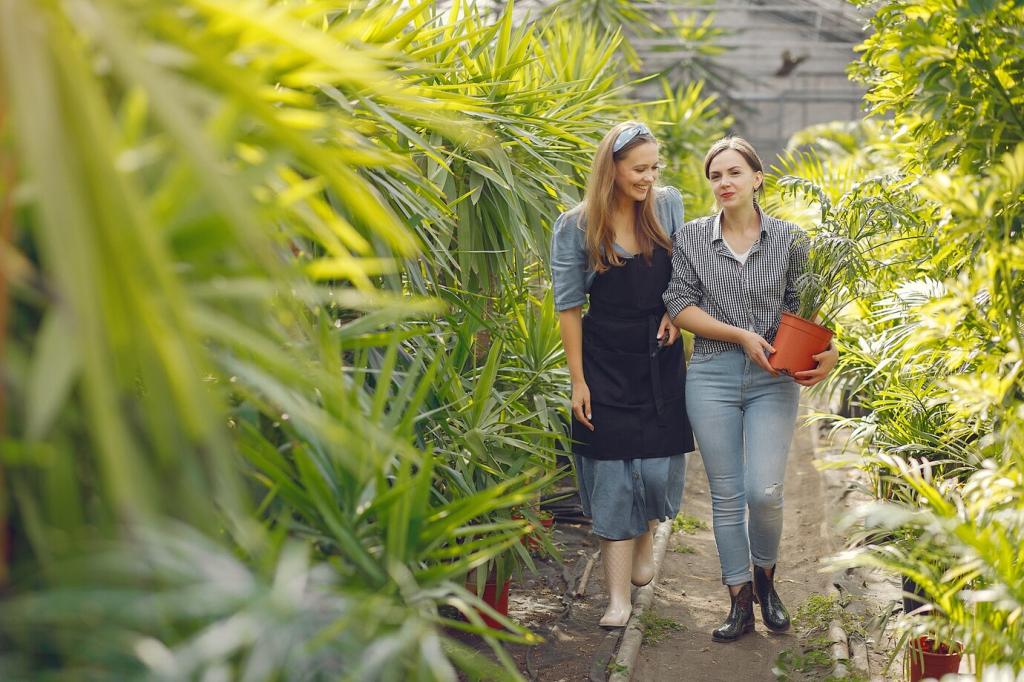Kitchen Garden Layouts for Beginners: Start Here
Chosen theme: Kitchen Garden Layouts for Beginners. Map your light, shape simple beds, and place crops with confidence. Expect practical tips, warm stories, and easy wins that make your first harvest feel inevitable. Join in, ask questions, and subscribe for weekly layout sketches tailored to small, real-life spaces.

Morning light matters
Map where the sun lands between 8 and 11 a.m.; most kitchen crops crave six or more hours. South-facing edges warm earliest. Shade from fences and trees shifts through the seasons, so observe for a week and jot notes before committing your beginner layout to paper.
Measure before you plant
Grab a tape measure and chalk. Beds no wider than four feet let you reach the center without stepping in and compacting soil. Mark future paths at least eighteen inches. You will thank yourself when tomatoes explode with growth and you still move comfortably between plants.
A tiny balcony can feed you
Containers arranged like a mini grid still count as a kitchen garden layout. Track wind tunnels, drip trays, and railing shadows. Cluster thirsty crops together and keep herbs within arm’s reach of your door. Small spaces thrive when access is easy and watering feels almost effortless.






Water, Paths, and Easy Access
Simple irrigation lines
Run a soaker hose in long, lazy loops through each bed and test pressure before planting. Water slow and deep, then mulch to lock in moisture. Beginners often overwater; the hose-and-mulch combo buys forgiveness. Add a basic timer and enjoy evenings without a frantic dash with the watering can.
Leave generous paths
Eighteen to twenty-four inches between beds lets you turn a wheelbarrow and kneel without crushing leaves. Paths are not wasted space; they are access lanes that protect your soil structure. Try wood chips or cardboard plus mulch, and share a picture of your path solution with our readers.
Keep herbs near the door
Convenience shapes behavior. When thyme and chives grow beside the entry, you will snip them nightly, and frequent harvests keep herbs bushy. A small, reachable herb strip can transform home cooking. Tell us which two herbs you grab most, and we will suggest a layout tweak for you.
Cool-season versus warm-season beds
Spinach, peas, and lettuce love cool temperatures and partial spring shade, while tomatoes, peppers, and basil demand heat. Assign one bed for early crops and another for summer lovers. When the season flips, your layout already has a plan, not a scramble. Beginners thrive with this gentle choreography.
Rotation reduces disease
Avoid planting tomatoes where tomatoes grew last year. Rotate families—nightshades, brassicas, legumes, and roots—so soil pests do not settle in. A simple notebook sketch and a phone reminder do wonders. Share your last season’s notes, and we will help you draft a smarter rotation map.
Succession planting keeps plates full
Sow a new square of lettuce every two weeks and follow harvested peas with bush beans. A neighbor told us his July salads stayed vibrant because he staggered plantings like calendar appointments. Add our newsletter to your inbox for gentle nudges about what to sow next and where.

Beginner-Friendly Sample Layouts
Place two trellised tomatoes on the north edge, basil at their feet, a two-by-three grid of lettuce in front, and a carrot block to the east. Border with marigolds. Paths stay open, harvesting is simple, and airflow stays generous. Post your sketch, and we will cheer your tweaks.
Beginner-Friendly Sample Layouts
Use three five-gallon buckets for determinate tomatoes, two for dwarf peppers, a wide bowl for cut-and-come-again lettuce, and a tall pot for pole beans with a slim trellis. Group by water needs. This compact layout feeds two people often. Comment with your balcony size for tailored suggestions.

